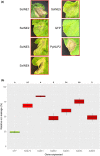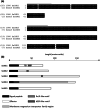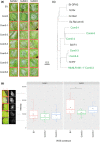The broad host range pathogen Sclerotinia sclerotiorum produces multiple effector proteins that induce host cell death intracellularly
- PMID: 37038612
- PMCID: PMC10346375
- DOI: 10.1111/mpp.13333
The broad host range pathogen Sclerotinia sclerotiorum produces multiple effector proteins that induce host cell death intracellularly
Abstract
Sclerotinia sclerotiorum is a broad host range necrotrophic fungal pathogen, which causes disease on many economically important crop species. S. sclerotiorum has been shown to secrete small effector proteins to kill host cells and acquire nutrients. We set out to discover novel necrosis-inducing effectors and characterize their activity using transient expression in Nicotiana benthamiana leaves. Five intracellular necrosis-inducing effectors were identified with differing host subcellular localization patterns, which were named intracellular necrosis-inducing effector 1-5 (SsINE1-5). We show for the first time a broad host range pathogen effector, SsINE1, that uses an RxLR-like motif to enter host cells. Furthermore, we provide preliminary evidence that SsINE5 induces necrosis via an NLR protein. All five of the identified effectors are highly conserved in globally sourced S. sclerotiorum isolates. Taken together, these results advance our understanding of the virulence mechanisms employed by S. sclerotiorum and reveal potential avenues for enhancing genetic resistance to this damaging fungal pathogen.
Keywords: NLR protein; RxLR motif; Sclerotinia sclerotiorum (white mould); effector; localization; necrotrophic fungus; plant pathogen.
© 2023 The Authors. Molecular Plant Pathology published by British Society for Plant Pathology and John Wiley & Sons Ltd.
Conflict of interest statement
The authors declare that they have no conflict of interest.
Figures






Similar articles
-
Variable Tandem Glycine-Rich Repeats Contribute to Cell Death-Inducing Activity of a Glycosylphosphatidylinositol-Anchored Cell Wall Protein That Is Associated with the Pathogenicity of Sclerotinia sclerotiorum.Microbiol Spectr. 2023 Jun 15;11(3):e0098623. doi: 10.1128/spectrum.00986-23. Epub 2023 May 4. Microbiol Spectr. 2023. PMID: 37140432 Free PMC article.
-
The evolutionary and molecular features of the broad-host-range plant pathogen Sclerotinia sclerotiorum.Mol Plant Pathol. 2022 Aug;23(8):1075-1090. doi: 10.1111/mpp.13221. Epub 2022 Apr 11. Mol Plant Pathol. 2022. PMID: 35411696 Free PMC article. Review.
-
Plant hypersensitive induced reaction protein facilitates cell death induced by secreted xylanase associated with the pathogenicity of Sclerotinia sclerotiorum.Plant J. 2024 Apr;118(1):90-105. doi: 10.1111/tpj.16593. Epub 2023 Dec 19. Plant J. 2024. PMID: 38113332
-
Receptor-Like Kinases BAK1 and SOBIR1 Are Required for Necrotizing Activity of a Novel Group of Sclerotinia sclerotiorum Necrosis-Inducing Effectors.Front Plant Sci. 2020 Jul 10;11:1021. doi: 10.3389/fpls.2020.01021. eCollection 2020. Front Plant Sci. 2020. PMID: 32754179 Free PMC article.
-
Mechanisms of Broad Host Range Necrotrophic Pathogenesis in Sclerotinia sclerotiorum.Phytopathology. 2018 Oct;108(10):1128-1140. doi: 10.1094/PHYTO-06-18-0197-RVW. Epub 2018 Aug 30. Phytopathology. 2018. PMID: 30048598 Review.
Cited by
-
Trans-Kingdom sRNA Silencing in Sclerotinia sclerotiorum for Crop Fungal Disease Management.Pathogens. 2025 Apr 21;14(4):398. doi: 10.3390/pathogens14040398. Pathogens. 2025. PMID: 40333207 Free PMC article. Review.
-
Population and genome-wide association studies of Sclerotinia sclerotiorum isolates collected from diverse host plants throughout the United States.Front Microbiol. 2023 Sep 27;14:1251003. doi: 10.3389/fmicb.2023.1251003. eCollection 2023. Front Microbiol. 2023. PMID: 37829452 Free PMC article.
-
Recombination and transposition drive genomic structural variation potentially impacting life history traits in a host-generalist fungal plant pathogen.BMC Biol. 2025 Apr 28;23(1):110. doi: 10.1186/s12915-025-02179-x. BMC Biol. 2025. PMID: 40289080 Free PMC article.
-
Genetic breakthroughs in the Brassica napus-Sclerotinia sclerotiorum interactions.Front Plant Sci. 2023 Nov 23;14:1276055. doi: 10.3389/fpls.2023.1276055. eCollection 2023. Front Plant Sci. 2023. PMID: 38078117 Free PMC article. Review.
-
The complex relationship between disease resistance and yield in crops.Plant Biotechnol J. 2024 Sep;22(9):2612-2623. doi: 10.1111/pbi.14373. Epub 2024 May 14. Plant Biotechnol J. 2024. PMID: 38743906 Free PMC article. Review.
References
-
- Antwi‐Boasiako, A. , Zheng, L. , Begum, N. , Amoah, S. & Zhao, T. (2021) Progress towards germplasm evaluation and genetic improvement for resistance to Sclerotinia white mold in soybean. Euphytica, 217, 1–18.
-
- Barbacci, A. , Navaud, O. , Mbengue, M. , Barascud, M. , Godiard, L. , Khafif, M. et al. (2020) Rapid identification of an Arabidopsis NLR gene as a candidate conferring susceptibility to Sclerotinia sclerotiorum using time‐resolved automated phenotyping. The Plant Journal, 103, 903–917. - PMC - PubMed
-
- Boland, G. & Hall, R. (1994) Index of plant hosts of Sclerotinia sclerotiorum . Canadian Journal of Plant Pathology, 16, 93–108.
Publication types
MeSH terms
Supplementary concepts
LinkOut - more resources
Full Text Sources

